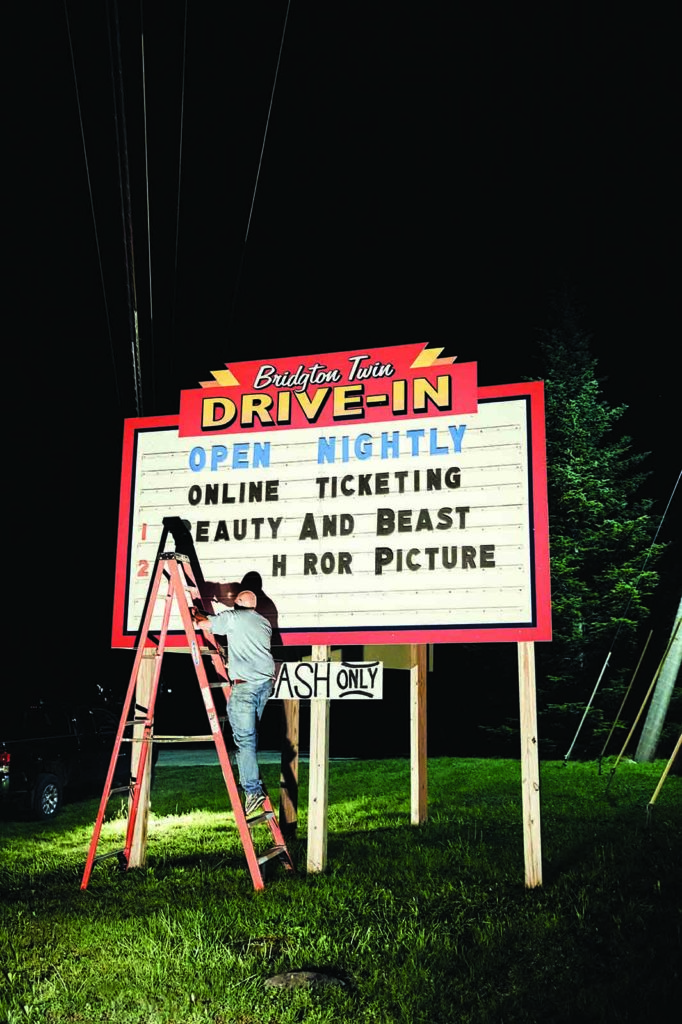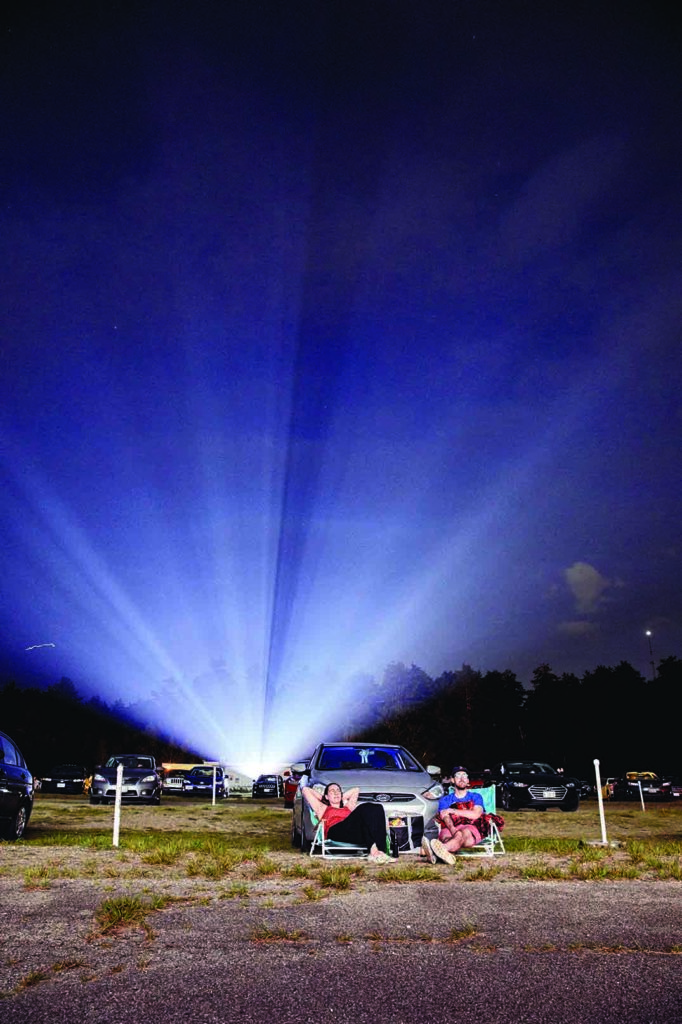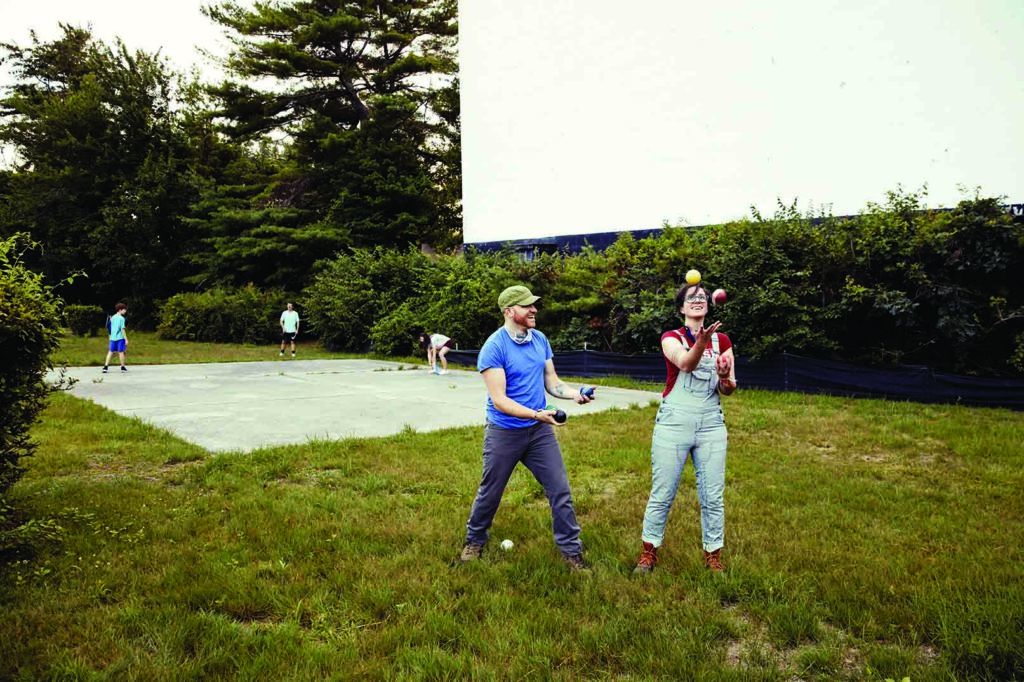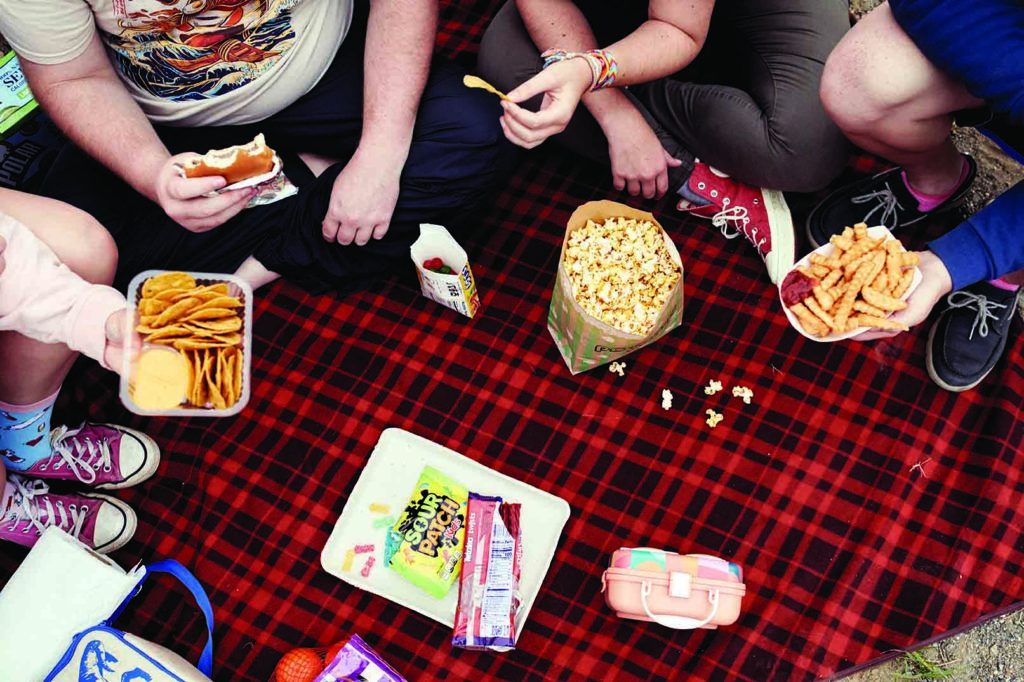Social, Distant at the Drive In
In a pandemic summer, few activities can go on as planned but the drive-in theater retains its retro charms

Social, Distant
at the Drive-In
In a pandemic summer, few activities can go on as planned but the drive-in theater retains its retro charms
by Katy Kelleher
Photography by Michael D. Wilson
Issue: October 2020
Atreyu is riding on Falkor’s back over the craggy, snow-dusted mountains of Fantasia, and I’m eating Skittles. After a 90-degree day, the air has finally cooled a bit with the disappearance of the sun. The sky behind the huge luminous screen, which now shows our young hero and his luckdragon companion landing near two sphinx statues, is purple and blue and dotted with clouds lit cotton-candy pink. The scent of hot buttery popcorn drifts from the concession stand nearby, and I take another sip of cold seltzer, pop another candy into my mouth. My cloth mask hangs loose around my neck—ready for action but blissfully unnecessary inside the confines of my car.
It’s a Friday night in July, and for the first time in months, my husband and I are out on a date. For $15, we bought a parking space at the Saco Drive-In Theater (an expensive bit of grass and gravel, a cheap movie ticket for a whole family). We have our baby with us, but she’s sleeping in my arms. We’ve been self-isolating for over one hundred days, and I haven’t hugged anyone aside from Garrett and Juniper (my husband and daughter, respectively) the entire time. Everything has changed, but The NeverEnding Story is exactly how I remembered it: epic, strange, silly, and fun.

For some communities, the drive-in theater has gone from being a local curiosity (or novel night out) to a social hub, hosting everything from live music to church services.
In March 2020 coronavirus disrupted every aspect of public life, perhaps irreversibly. Schools shut down, offices closed, and movie theaters shut their doors. It wasn’t safe to sit in a dark room with hundreds of other people and share a cinematic experience. We were breathing too much of the same air for too long. Even from the beginning, we knew some people were more susceptible to the disease than others. Cancer survivors, like my husband, were at high risk.
In May, while schools, offices, restaurants, and retailers remained closed, Maine’s seven drive-in theaters began to open for business. They showed movies, of course, but they also hosted stand-up comedy nights, live concerts, dance recitals, and even church services. “The first six weeks, we sold out every night,” says John Moore, owner of the Narrow Gauge Cinemas in Farmington, a property that includes a drive-in, a grill, and an indoor movie theater. “People were so excited to finally get out of the house. Everyone was in a good mood because they were able to do something quote-unquote normal, and they hadn’t done that in a long time.”
By July, other services had started to open back up, but my family still wasn’t going out to enjoy the air conditioning at the Maine Mall or driving downtown to get dinner together at our favorite sushi restaurant. We weren’t going to do most of our “normal” summer activities, because we didn’t feel safe. Our date at the drive-in didn’t feel normal, because we don’t normally go to drive-ins. And before the pandemic, I had never worn a cloth mask in my life. Yet that’s the word I keep hearing, usually in scare quotes or italics. Normal.

At the Saco Drive-In, concession stands are open—but with safety measures in place. 
Customers are encouraged to use cash, and to use the bathroom before they leave home; rather than doing the traditional double feature, most drive-ins are opting to show just one movie per night (to cut down on bathroom breaks).
“We typically go to the drive-in a couple times a year,” wrote Richele Grenier Chatto in response to my emailed questions about drive-in experiences. She had just recently seen Jaws at the Saco Drive-In, where she met Maine magazine photographer Michael D. Wilson. Grenier Chatto explained that she had been “more eager to go to the drive-in this year, as it gets us out of the house and gives us something to do that feels both ‘normal’ and safe.” She added, “To us it did not feel weird at all.” The only really strange thing about the night was meeting a professional photographer—everything else, from the privacy of the car to the communal experience of watching a film with hundreds of strangers—felt, well, normal. Normal enough, at least.
Drive-ins were once a regular part of American entertainment. While the first drive-up movie was shown in Mexico City, the practice was perfected and patented by American entrepreneurs in the 1930s. The first major theater opened in New Jersey in 1933 with 400 slots for cars and the slogan “The whole family is welcome, regardless of how noisy the children are,” according to a brief history of the phenomenon in Wired magazine. After World War II, Americans began flocking to the drive-in in droves, partially because young couples were having lots of little kids. This generation would come to be known as the Baby Boomers. They were the first Americans to grow up with drive-in theaters. And for a while, it looked like their children might be the last generation to enjoy the activity.

The drive-in rose to prominence in the early twentieth century, and many theaters still show influence of the era in their design, decor, and marketing. 
Moviegoers watching Call of the Wild at the Bridgton Twin Drive-In.
Before coronavirus hit, drive-in theaters had been slowly shuttering, one by one, across the country. Major studios stopped releasing movies on film in the mid-2010s, which forced the surviving drive-ins to make the expensive conversion to digital. It was never particularly easy to make a living owning a drive-in theater, and the availability of streaming video only made matters worse. Car culture peaked in America in the 1940s and 1950s, an era that also marked the high-water point for drive-ins. But just as there are still classic-car enthusiasts and greased-hair singers making rockabilly-style music, there are still people who love the drive-in and go every year. A few years ago, I would have considered seeing a drive-in movie a nostalgic activity, something that reminded me of my childhood vacations on Cape Cod. Now it seems oddly of-the-moment.
“For once the drive-in industry is well-positioned to survive,” says John Tevanian, who owns the Bridgton Twin Drive-In in Bridgton. “Obviously, I’m not hoping for a pandemic every year. But being able to go out, to be in your own little bubble, and to do something fun, that’s a really positive thing.” Bridgton is a tourist area. Most businesses rely on summer visitors to pay the rent year-round. This year, with fewer people coming to Maine and even fewer going out in Maine, restaurants and traditional theaters are suffering greatly. Even while Tevanian reveals that his profits are down 30 percent for the year, he still insists, “I’m not complaining.” He feels lucky compared to the restaurants, bars, and shops that line the streets of Bridgton—and his overall costs are down. “Studios are being cooperative,” he says. “They’ve offered terms that are much cheaper than normal, so it’s less of a risk for us.”

“For once the drive-in industry is well-positioned to survive. Obviously, I’m not hoping for a pandemic every year. But being able to go out, to be in your own little bubble, and to do something fun, that’s a really positive thing.”
With indoor theaters closed, studios delayed the releases of their summer blockbusters, like Tenet (a Christopher Nolan film starring John David Washington and Robert Pattinson). It would be impossible for them to make back the money they invested in creating such high-budget movies. But with drive-ins open, it does make sense to allow theaters to air something. As a compromise of sorts, studios have offered drive-in owners discounts to license old movies. Some are family-friendly crowd pleasers (think Wizard of Oz and Zootopia), others are action powerhouses (like Jaws or Raiders of the Lost Ark), and some are comedy classics (Ferris Bueller’s Day Off, The Princess Bride). “In any other year, if you opened the season with The Wizard of Oz, you would be lucky to have five cars,” says Tevanian. “But this year, my brother down at Prides Corner sold out. With The Wizard of Oz!” It’s not quite inconceivable, but it’s close.

Jed Thomas learns to juggle from Kit McCann before the start of a showing of Jaws at the Saco Drive-In.

Andrew Tevanian, brother of the Bridgton Twin Drive-In owner John Tevanian, with his dog. 
General manager Matthew Roberge waits for customers to arrive at the Saco Drive-In. Thanks to online ticketing, many people arrive having already paid and signed in, and just need to give their names and choose a parking spot.
Concession stand sales are down, ticket sales are down, attendance is down, and yet drive-in owners are still doing alright. Business isn’t booming, but there’s a steady stream of cars coming in. To distinguish it from his day job, Matt Roberge, manager of the Saco Drive-In, calls operating the theater his “fun job.” His nine-to-five in material procurement is “pretty mundane, but it pays the bills.” Operating a theater isn’t enough; it’s a passion project, one that many Saco residents are grateful Roberge took on. It’s always a little difficult to juggle his two jobs, but this year has been “extra stressful,” he says. “We had to do a lot of preparations to make sure we could offer a safe experience for our guests. I’ve definitely had a persistent headache this year from the added stress, but it feels like we are hitting our stride now this season, and settling into the new normal.”
As the saying goes, nothing gold can stay. Just 90 minutes into my drive-in experience, I’m forced to leave early. The teething baby woke up and started to scream. Something startled her—a loud noise from the epic drama taking place on screen—and I can’t soothe her. Instead, we drive with our lights off, weaving between the rows of cars and hoping we won’t disturb anyone’s movie night as we exit. A few kids are clustered over by the concession stand. One other car pulls out behind us, another untimely exit. I wonder if they have tired kids in the back, too.
I think I might have felt bad about leaving early, if this had been a normal night out, in normal times, before the pandemic blew up our lives. But we’ve seen this movie before. We weren’t really there to watch Atreyu and his luckdragon save the Childlike Empress. We were looking for emotions, not entertainment. We wanted to feel like social creatures, like adults.

Friends enjoy a picnic at the Saco Drive-In.
The drive-in delivered. I know I’ll go back, because I still don’t feel safe with other kinds of public mingling. It’s impossible to know how long this virus will continue circulating, continue killing. Everyone, including the theater owners, hopes it will leave us alone, or that we’ll beat it. Even Tevanian, who calls himself “really happy” with how the year is going, says the model is “only OK for the environment we’re in.” There’s something sweet about the idea of seeing a classic movie in a retro environment, and it would be easy to drift too far into nostalgia. But that’s not the whole picture. It’s working, but barely. Drive-ins are making do, but barely. We went out, but barely.
“The drive-in is relevant right now, which is a good thing for me, but I don’t know what next year brings,” says Moore. Even if we do get a vaccine sooner rather than later, Moore doubts people will feel comfortable going to traditional cinemas as often as they used to. “You know the people from the Depression era who refuse to throw away anything, who will cut around the mold on cheese and eat it anyway? This might be like that. It might have the same resonating effect.”
His drive-in has only been open for four years, which is nothing compared to the 33 years he’s owned and operated a regular cinema. He’s always loved movies, and he grew up going to drive-ins with his parents. “I thought it could be cool, retro,” Moore says. “I thought it would be fun. But I never thought there would be social distancing and a drive-in would be needed like this.”

“We have always liked going to the drive-in, but I will admit we have frequented them in this pandemic more than ever before,” says Tianna Burton, who attended a screening of The Call of the Wild in Bridgton with her husband, kids, and her friend Beth (whose birthday inspired the outing). “It’s nice to see friends and neighbors out having a good time and still be able to follow social distancing guidelines and feel safe,” she says. “It’s important to my husband and I that our kids find ways to safely socialize and the drive-in gives us a chance to do that.”

